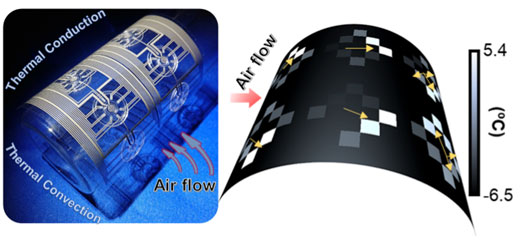| Nov 26, 2019 | |
Observing flow distribution over curved surfaces |
|
| (Nanowerk Spotlight) Flow separation is a common phenomenon affecting aircraft, wind turbine blades, micro aerials, and underwater vehicles. Owing to its unsteady flow profile, such separation is usually undesirable because either the airfoil efficiency decreases or large pressure fluctuations emerge. Consequently, precise monitoring is crucial to reduce or even prevent the flow separation effect. | |
| Current flow monitoring relies on bulk silicon-based microelectromechanical system (MEMS) technology. However, conventional MEMS-based flow sensors have the disadvantage of disturbing the nature of the initial air flow during the large-area flow detection. In addition, most of these devices are based on rigid materials, so their mechanical flexibility is poor. Flow sensor devices built from a flexible thin-film would be able to tackle this problem. | |
| In a recent study published in ACS Nano ("Highly Precise Multifunctional Thermal Management-Based Flexible Sensing Sheets"), researchers from Osaka Prefecture University (OPU) demonstrated the first large-scale flexible thermal flow sensor array on a thin-film through judicious manipulation of thermal energy transfer. | |
| The flow sensor – based on a calorimetric sensing mechanism – can not only monitor flow intensity but also flow direction. More importantly, these sensors can be attached onto curved surfaces for real-time flow monitoring. | |
| To precisely monitor flow without being disturbed by the external environment, the OPU team incorporates a low thermal conductivity medium (i.e. air) with the flexible flow sensing sheets. The strategy of efficient thermal management allows the proposed flow sensor array to accurately monitor flow over high thermal conductive materials, such as for instance metal. | |
| In addition, the thermal management-based sensing sheet can also be extended to wearable electronics for precise skin temperature measurement. | |
| "When conceiving thermal-related sensing techniques it is very important to consider the thermal energy transfer with the external environment," says Dr. Kaichen Xu, first author of this publication. "The untethered heat transfer between an object's surface and its surroundings generally restricts the thermal perception within a localized governable space. Our work affords a pathway to conceive thermal-based or transduction flexible sensors for emerging Internet of Things (IoT) applications." | |
 |
|
| Figure 1. Large scale thermal flow sensor array attached onto a tube (diameter: 7.5 cm) (left), and corresponding flow mapping results (right). (Reprinted with permission by American Chemical Society) | |
| The researchers integrated their large-scale flow sensor array onto a polyethylene terephthalate (PET) film with screen-printed silver as the interconnect electrodes (Figure 1). Each pixel is composed of one heater homogeneously surrounded by eight temperature sensors, presenting eight flow directions. The air cavity embedded in PDMS was then used to protect the sensor against the harsh external environment. | |
| "We have made a breakthrough in developing macroscale flexible flow sensor arrays that can measure flow distribution without disturbing the initial pristine nature of air flow," Prof. Kuniharu Takei, who led this project, points out. "This technique provides a guidance for investigating flow separation induced by airfoil and other aerodynamics. Additionally, the thermal-regulated temperature sensor can precisely monitor skin temperature even if the ambient conditions change abruptly." | |
 |
|
| Figure 2. Photo of the skin temperature sensor patch with and without PDMS air cavity protection attached onto a volunteer's arm (left) and real-time monitoring of skin temperature in different ambient environments (right). (Reprinted with permission by American Chemical Society) (click on image to enlarge) | |
| Initially, both temperature sensors (with and without PDMS air cavity protection) provide almost the same result for the skin temperature measurement (∼34 °C) due to the thermal dynamic equilibrium (see Figure 2). Then, the volunteer walked from a room at ∼26.5 °C outside, which had a much lower ambient temperature of ∼7.0 °C. The temperature sensor without a thermal-regulated structure shows a subtle discrepancy and is accompanied by slight temperature fluctuations compared to the other two sensors with more than 2 °C difference. | |
| In their ongoing work, the researchers will now need to address several tasks such as seeking lower thermal conductive media to form thinner effective thermal barriers; system integration with other sensors for exact healthcare monitoring; and a larger thermal working range. To minimize the electrical interconnections for macroscale applications they also need to develop a multiplexed detection strategy. | |
| Readers might also be interested in the authors' recent review paper on multifunctional flexible sensor systems in Advanced Materials Technologies ("Multifunctional Skin-Inspired Flexible Sensor Systems for Wearable Electronics") published as part of the special series on Advanced Intelligent Systems. | |
|
Provided as a Nanowerk exclusive by the Department of Physics and Electronics, Osaka Prefecture University
|
|
|
Become a Spotlight guest author! Join our large and growing group of guest contributors. Have you just published a scientific paper or have other exciting developments to share with the nanotechnology community? Here is how to publish on nanowerk.com. |
|
